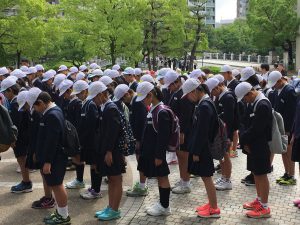I’m not sure where or how to start this post. The very name of this place forces one to consider, remember, react, wonder at the actions of men in wartime and grieve for it all. It is impossible to remain indifferent after a visit here.
On August 6, 1945 at 8:15AM, the Enola Gay dropped “little boy”, the first atomic bomb, on Hiroshima, which detonated 600 m above the Industrial Promotion Hall in the center of the city. This building, designed in the European style by a Czech architect, wasn’t totally destroyed like most around it because the bomb exploded almost directly overhead. Now called the A-Bomb Dome, it remains as a reminder of the devastation of the war, and the bomb. And as a warning to future generations.
By the end of 1945 over 140,000 people had died; 80,000 in the initial blast, and the remainder from various after-effects of burns and radiation poisoning. Across the river from the A-Bomb Dome is the Peace Park, which includes the Hiroshima National Peace Memorial Hall for the Atomic Bomb Victims, the Hiroshima Peace Memorial Museum and the Children’s Peace Monument, as well as the Peace Bell, and other sculptures designed to remember the victims, and more importantly to promote peace.
In exploring the park, there were 3 areas, each with variations of emphasis, that touched me deeply. The first was the Children’s Peace Monument, a statue on a granite pedestal, which was erected in memory of a girl named Sasaki Sadako, who died at the age of 12 of leukemia caused by radiation. She was two years old at the time of the explosion and she was just 2km from the epicenter. Diagnosed in 1954 , she hoped to recover, so Sadako set about folding 1,000 origami cranes. According to Japanese tradition, anyone who accomplishes this task will see his or her wish granted. She had time to make 644 before she died. Her classmates continued folding cranes and collected money to erect a monument. Since then, children around the world have been folding cranes and sending them to Hiroshima, where they are placed around the statue. Today there were about a dozen school groups, and each would stand around the monument, say some things in unison, sing a song and deliver a long strand of origami cranes to add to the stands full of them. (Check FB for a video of the children).
The second place was the Memorial Hall for the Victims. A spare round monument with a downward slope took you to a room that provided a 360 degree view of Hiroshima after the blast. There are 140,000 tiles to mark the number of victims who are estimated to have died. There’s a fountain in the center which is a sculpture that depicts a clock face showing 8:15, and offers water to the victims, many of whom cried out in thirst in the first hours after the devastation. Like the Vietnam Veterans wall, you can search for specific people in a database, and there’s a rotating wall of photos of victims. It was in this memorial that you can watch a film made up of first hand stories provided to the city about 5 years after the bomb. There were also written accounts from the day, which had been solicited from survivors to ensure that they are not lost to history. Hibakusha, or survivors, and their children were (and still are) victims of severe discrimination when it comes to prospects of marriage or work, and so many don’t self-identify as such. The call for these first hand stories went out to all, and only 165 were submitted.
Lastly, the Peace Memorial Museum. While the main building is undergoing renovation, the East Wing was still very impressive, and the focus seemed to be on the history of the atomic and hydrogen bombs. Starting with the Manhattan Project, and hitting lightly on the options and efforts to contain Japan before the decision to use the A and H bombs on Hiroshima and Nagasaki, the exhibit spent a lot of effort on the importance of “never again”. There were sections on the various START and New START agreements, as well as the other regional treaties agreeing to not develop the capability, while also noting the number of countries around the globe that do have the bomb, and how the various tests over the decades have sent much radiation into the atmosphere severely sickening civilians. The focus of the museum, from the artifacts that have been donated from personal archives, to the stories of the re-birth of Hiroshima, is peace and learning from history.
President Obama (I sure miss him!) was the first president of any nuclear armed nation to visit Hiroshima, and while there were some that suggested that it was critical that he issue an apology, his written words, housed in the museum, along with a few origami cranes that he made, serve to be a reminder of the effects of war on all people:
“We have known the agony of war. Let us find the courage, together, to spread peace and pursue a world without nuclear weapons.”
















